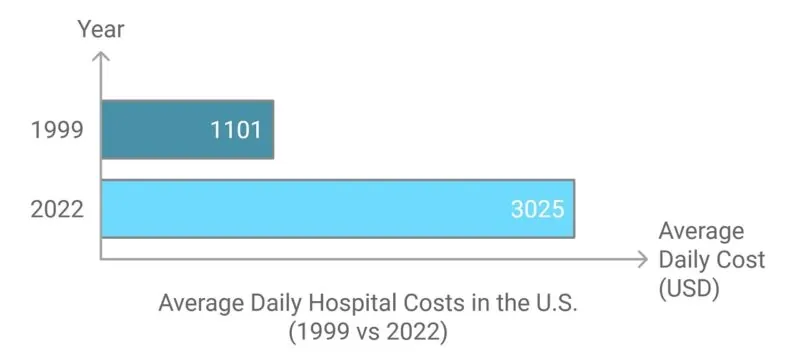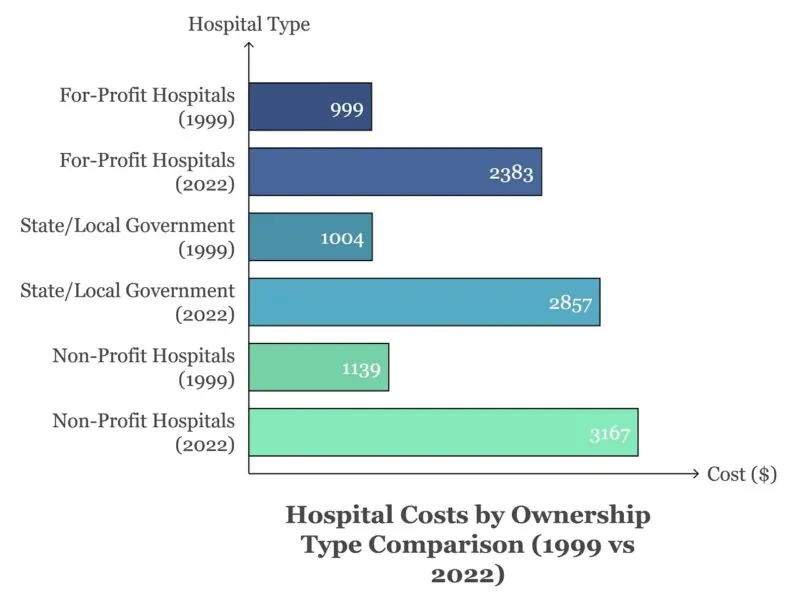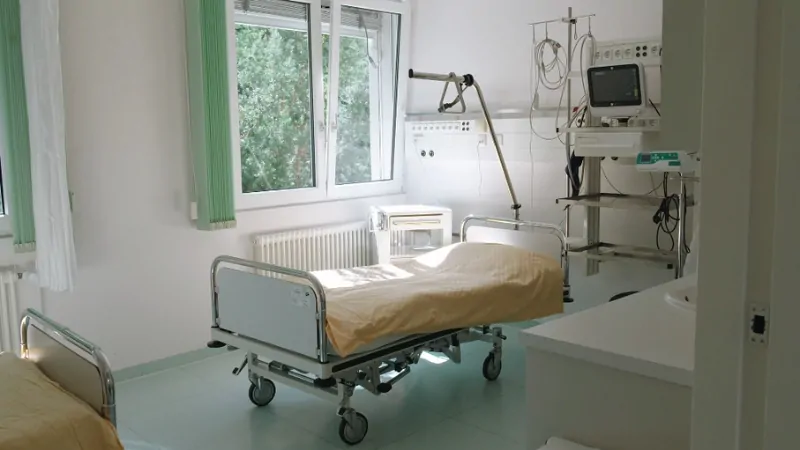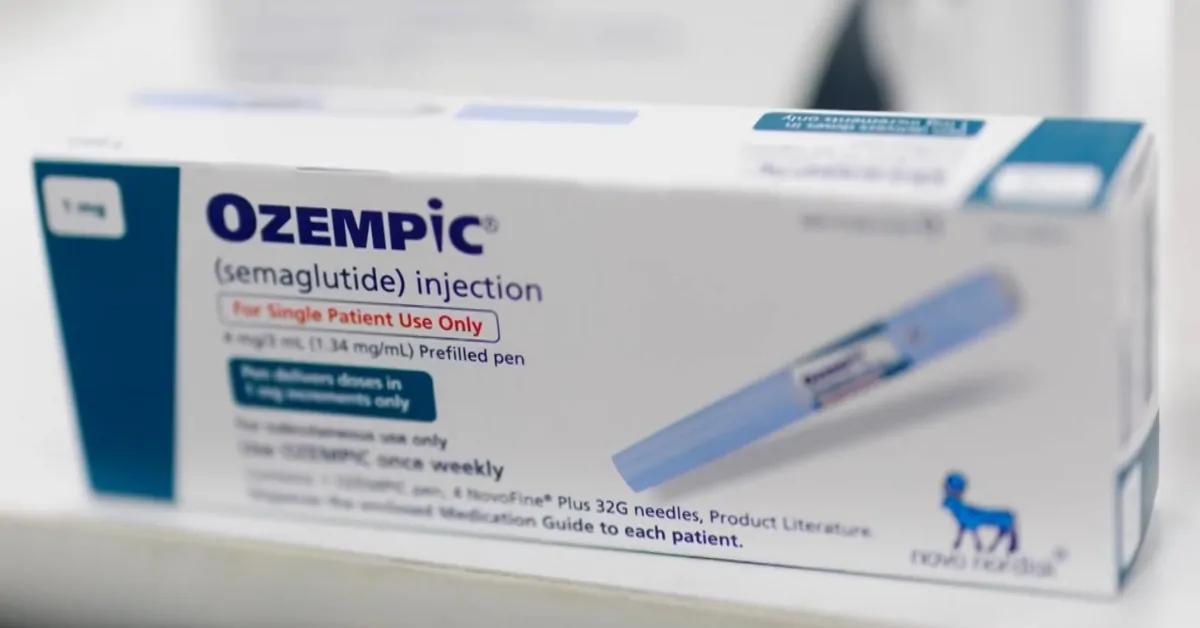There were more than 34 million hospital admissions in the United States in 2021.
According to a recent study, the average American earning a standard wage would need to work a staggering 384 hours just to cover the cost of a typical hospital stay.
Of course, these costs aren’t uniform across the country—they vary significantly from state to state.
Curious about where residents face the highest and lowest workloads to afford hospital care?
Keep reading to discover the state-by-state breakdown, along with tips on how to make the most of your health insurance to help manage these costs.
Table of Contents
ToggleState-by-State Analysis

| State | Average Cost per Inpatient Day |
| United States | $3,025 |
| Alabama | $1,899 |
| Alaska | $2,230 |
| Arizona | $3,243 |
| Arkansas | $2,266 |
| California | $4,337 |
| Colorado | $3,567 |
| Connecticut | $3,266 |
| Delaware | $3,359 |
| District of Columbia | $4,068 |
| Florida | $2,826 |
| Georgia | $2,282 |
| Hawaii | $3,117 |
| Idaho | $3,666 |
| Illinois | $3,181 |
| Indiana | $3,175 |
| Iowa | $1,880 |
| Kansas | $2,340 |
| Kentucky | $2,612 |
| Louisiana | $2,632 |
| Maine | $2,887 |
| Maryland | $3,609 |
| Massachusetts | $3,529 |
| Michigan | $2,475 |
| Minnesota | $2,745 |
| Mississippi | $1,425 |
| Missouri | $2,743 |
| Montana | $2,198 |
| Nebraska | $2,729 |
| Nevada | $2,410 |
| New Hampshire | $3,000 |
| New Jersey | $3,296 |
| New Mexico | $3,054 |
| New York | $3,714 |
| North Carolina | $2,677 |
| North Dakota | $2,329 |
| Ohio | $3,392 |
| Oklahoma | $2,379 |
| Oregon | $4,003 |
| Pennsylvania | $2,989 |
| Rhode Island | $3,102 |
| South Carolina | $2,390 |
| South Dakota | $1,719 |
| Tennessee | $2,590 |
| Texas | $3,060 |
| Utah | $3,500 |
| Vermont | $3,079 |
| Virginia | $2,871 |
| Washington | $3,843 |
| West Virginia | $2,240 |
| Wisconsin | $2,804 |
| Wyoming | $1,761 |
KFF notes that hospital costs per inpatient day vary significantly across the United States, with the national average sitting at $3,025.
States like California and Oregon report the highest expenses, exceeding $4,000 per day, driven by high living costs and advanced medical facilities.
Conversely, states like Mississippi and South Dakota, with costs below $1,800, reflect lower operational and wage expenses.
Regional differences are influenced by factors such as healthcare infrastructure, economic conditions, and state policies.
Operational expenses also vary by state, and in regions like Alabama, partnerships with providers such as Trihaz Solutions help hospitals maintain tighter control over waste management costs.
Hospital Stay Costs in the U.S. (1999 – 2022)

The cost of a hospital stay per day in the United States has experienced a sharp upward trend over the past two decades.
According to data from ConsumerShield from 1999 to 2022, the average daily hospital cost has risen from $1,101 in 1999 to $3,025 in 2022, marking a staggering increase of approximately 175% over 23 years.
This growth is driven by a combination of factors such as inflation, advancements in medical technology, and changes in healthcare regulations.
Changes in Hospital Costs Over Time

The table below highlights the year-by-year increase in average hospital stay costs:
| Year | Cost per Day (USD) | Yearly Percentage Increase (%) |
| 1999 | $1,101.80 | – |
| 2000 | $1,148.47 | 4.24% |
| 2005 | $1,522.42 | 6.80% |
| 2010 | $1,909.64 | 3.08% |
| 2015 | $2,270.51 | 4.05% |
| 2020 | $2,873.01 | 6.11% |
| 2022 | $3,025.23 | 5.30% |
Key Trends
- From 1999 to 2005, costs rose steadily, reaching $1,522, with annual increases averaging about 5.8%.
- Between 2010 and 2020, hospital costs saw a more rapid climb, averaging 5% annually.
- The most significant jump occurred between 2020 and 2022, when costs increased by over $150 per day.
Factors That Affect Hospital Stay Costs
Hospital costs are influenced by a variety of factors, including:
- Type of Hospital: Costs vary depending on ownership—state, non-profit, or for-profit.
- Location: Hospitals in urban areas often have higher operational costs than rural ones.
- Medical Condition: Complex conditions requiring specialized care drive up costs.
- Length of Stay: Longer stays naturally accumulate higher charges.
Hospital Costs by Ownership Type
Ownership plays a critical role in determining hospital stay costs:

- For-Profit Hospitals: Typically offer lower costs due to streamlined operations.
- State/Local Government Hospitals: Competitive pricing, though these hospitals often balance care quality with cost control.
- Non-Profit Hospitals: Tend to have the highest costs due to their broader service offerings and investments in community health programs.
Rising Costs and What Do They Mean?

The consistent rise in hospital costs underscores the growing financial burden on patients, according to an NCBI study. For example:
- In 1999, a patient might pay around $1,100 per day for hospital care.
- In 2022, the same patient would face a cost of over $3,000—an almost threefold increase.
To manage these costs, individuals should:
- Understand Their Insurance: Ensure adequate coverage for inpatient stays.
- Negotiate Bills: Many hospitals offer payment plans or discounts for uninsured patients.
- Plan Ahead: Discuss estimated costs with providers before elective hospitalizations
How Infections Drive Up Expenses
Healthcare-Associated Infections (HAIs) significantly impact hospital stay costs in the United States.
According to the Agency for Healthcare Research and Quality (AHRQ), in 2019 and 2021, inpatient stays involving HAIs had longer median lengths of stay, higher in-hospital mortality rates, and increased median hospital costs compared to stays without HAIs.
These infections not only affect patient health outcomes but also contribute to the escalating expenses associated with hospital care. Implementing stringent infection control measures is essential to mitigate these costs and improve patient safety.
Most Common Reasons for Hospital Admission in the U.S. (2020)
The Agency for Healthcare Research and Quality (AHRQ), part of the U.S. Department of Health and Human Services, tracked the most frequent diagnoses that led to inpatient hospital stays in 2020, excluding births and newborns. The following table shows how the number of hospital stays for each condition changed between 2018 and 2020, as well as the average cost per hospital stay.
Notably, the overall number of admissions fell for most conditions in 2020, a trend largely linked to the impact of COVID-19, as fewer people sought hospital care for non-COVID health issues.
| Diagnosis | Hospital Stays (2018) | Hospital Stays (2020) | Average Cost per Stay |
|---|---|---|---|
| Septicemia | 2,218,800 | 2,396,400 | $18,244 |
| COVID-19 | N/A | 1,058,815 | $11,275 |
| Heart failure | 1,135,900 | 1,003,270 | $13,418 |
| Diabetes (with complications) | 678,600 | 659,950 | $8,439 |
| Osteoarthritis | 1,128,100 | 606,741 | $16,000 |
| Acute myocardial infarction (heart attack) | 658,600 | 570,440 | $18,931 |
| Pneumonia (non-tuberculosis) | 740,700 | 560,450 | $6,042 |
| Cardiac dysrhythmias (irregular heartbeat) | 620,000 | 526,635 | $12,100 |
| Cerebral infarction (stroke) | 533,400 | 515,400 | $14,900 |
| Acute/unspecified renal failure | 565,800 | 470,635 | $9,600 |
How Much Does an Average Overnight Hospital Stay Cost?

When asking, “How much does an average overnight hospital stay cost?“, the answer depends heavily on location, insurance coverage, and type of hospital.
According to the latest data from KFF and ConsumerShield, in 2022, the national average cost for a single overnight hospital stay in the United States was approximately $3,025 per day.
However, this number fluctuates widely:
- In California and Oregon, an overnight stay can exceed $4,000.
- Meanwhile, states like Mississippi and South Dakota offer considerably lower rates, with average costs under $1,800 per night.
Factors such as urban vs. rural hospital settings, ownership types (for-profit vs. non-profit), and patient medical needs heavily impact overnight charges.
Without insurance, even a simple overnight observation can become financially overwhelming for many Americans.
UCSF’s published 2023 price list shows daily room rates for a standard inpatient room around $4,300 per day.
3-Day Hospital Stay Cost With Insurance

On average, with standard health insurance coverage, patients still face substantial out-of-pocket costs due to deductibles, copays, and uncovered services.
- Typical billed charge (without insurance) for a 3-day hospital stay without insurance: around $9,000 ($3,025 × 3 days).
- Average out-of-pocket cost with insurance: $1,300 – $2,500, depending on the plan.
For example:
- A bronze-tier Affordable Care Act (ACA) plan may cover only 60% after the deductible is met.
- High-deductible health plans (HDHPs) often leave patients responsible for the first $2,000–$7,000 before insurance coverage even kicks in.
Hospitalizations involving surgery, specialized treatments, or intensive care can easily push the insured 3-day hospital stay costs even higher.
According to Healthcare Cost Institute (HCCI), insured Americans still paid an average of $1,982 out of pocket for inpatient stays in 2022, up 11% from five years earlier.
Overnight Hospital Stay Cost With Insurance

Here’s what patients typically face:
- Average billed charge: About $3,025 for one night.
- After insurance (depending on plan):
- Copays for hospitalization: typically $250–$500 per stay.
- Coinsurance: often 20% of the total bill after meeting the deductible.
- Typical overnight hospital stay out-of-pocket cost: around $500 to $1,200.
Insurance plans may have different structures:
- PPOs (Preferred Provider Organizations) often have better negotiated hospital rates.
- HMOs (Health Maintenance Organizations) may require pre-authorization or referrals.
- HDHPs (High-Deductible Health Plans) result in higher upfront payments before coverage kicks in.
Patients are advised to:
- Verify hospital network status before treatment.
- Review insurance plan details (copay vs. coinsurance).
- Ask for cost estimates and negotiate where possible.
FAQ
The average cost of a one-night hospital stay in the United States is approximately $3,025.
However, the cost can range from $1,400 to over $4,000, depending on the state, hospital type, and services provided.
Patients with health insurance typically pay much lower amounts after deductibles and copays.
Inpatient rehab costs vary widely based on facility type, location, and treatment programs.
On average, a 30-day stay at an inpatient rehabilitation center may cost between $6,000 and $20,000, depending on the level of care provided.
Some programs, especially those offering medical detox or luxury accommodations, can exceed these averages.
Finding the right rehabilitation center is essential for effective recovery.
To quickly locate options tailored to your needs, you can use the comprehensive Rehabs Near Me Directory from Addiction Center.
This resource helps you find licensed alcohol rehab centers, drug rehab programs, and inpatient treatment facilities close to your location.
If you need to rent a hospital bed for home recovery after discharge, there are many medical equipment suppliers available locally.
Prices typically range between $150 and $500 per month, depending on the type of bed and included services like delivery and setup.
You can search online for “hospital bed rental near me” or check recommended resources for local options.
Hospital bills often include charges for room and board, medical procedures, medications, equipment use, and physician services.
It’s important to carefully review your hospital bill and insurance Explanation of Benefits (EOB).
Negotiating payment plans, requesting itemized bills, and verifying charges can significantly reduce out-of-pocket costs.
Methodology
- We gathered the latest national and state-specific hospital cost data from reputable sources such as KFF, AHRQ, and ConsumerShield.
- We analyzed trends from 1999 to 2022 to highlight long-term cost increases and inflation-adjusted pricing shifts.
- A state-by-state cost comparison table was created to show regional disparities in average inpatient day costs.
- We included key factors influencing hospital pricing, such as ownership type, geography, and type of care.
- Real-world cost examples with and without insurance were integrated to help readers understand potential out-of-pocket expenses.
- Practical tips and FAQ sections were added to guide readers in managing, estimating, and reducing hospital-related financial burdens.
Conclusion
Hospital stay costs in the U.S. have surged dramatically over the past 23 years, fueled by inflation, technological advancements, and other economic factors.
Getting to know these trends and the role of hospital ownership in pricing can help patients navigate healthcare costs more effectively.
By planning and leveraging resources like insurance and financial assistance programs, individuals can better manage the financial impact of hospital stays.
Related Posts:
- Cancer Deaths Could Nearly Double by 2050 If the…
- No New Timeline for Brockton Hospital’s Reopening After Fire
- Fair Pricing Act Could Set First Cap on Hospital…
- Is Sicily Expensive in 2025? A Complete Cost Analysis
- How Much Does a Wedding Cost in the United States in 2025?
- How Much Do Retainers Cost? Price Ranges You Should Know








